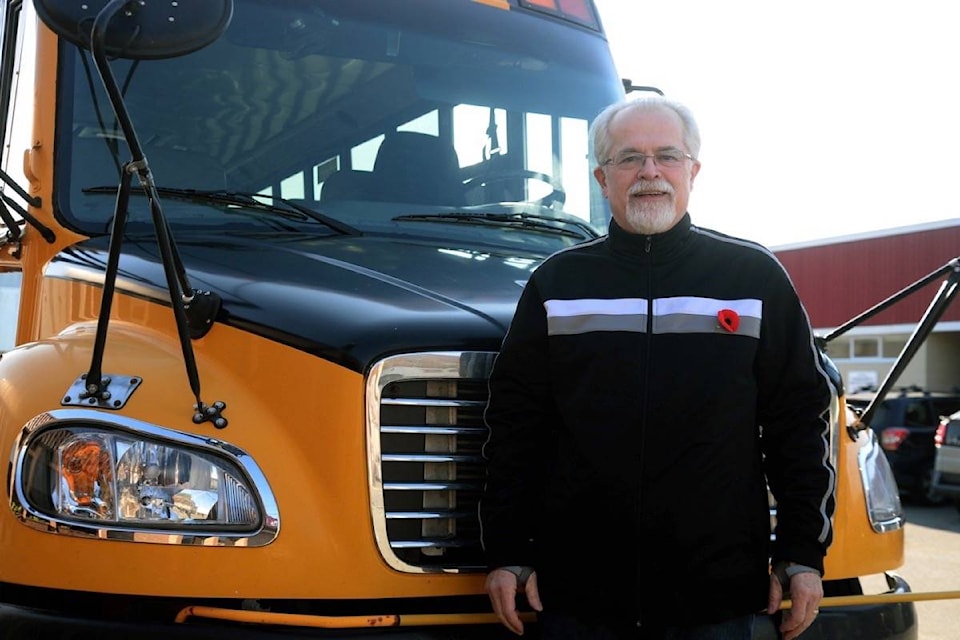An Agassiz-based school bus driver has started an online petition asking the government for seat belts on Canadian school buses.
Gary Lillico, a three-year Harrison resident, has only been driving the bus since September, but quickly formed an opinion on school bus seatbelts, or the lack thereof.
His route takes Highway 1 and traverses the narrow Agassiz Rosedale Bridge. While high seat backs are designed to protect kids in the bus, Lillico wonders what might happen if, in a worst case scenario, the bus was ever hit from the side or rolled.
Plus he says he has a hard time getting kids to stay seated in the first place.
“I’ve had little girls trying to do somersaults and go over seats,” he said. “They’re so young, they don’t get it. That’s another reason for being belted in.”
Related: Parents of Humboldt Broncos player killed in crash sue truck driver, bus maker
But there’s more to the story behind Lillico’s passionate plea for belts.
Three years ago, just after he and his wife had moved to Harrison Hot Springs, Lillico was in a serious car accident. After dropping off his grandson in Tsawwassen, he went through a green light at a busy intersection where he says he struck a left-turning driver who had misjudged his turn.
Lillico experienced frontal whiplash and lasting injuries to the knuckles in his hands. A long, difficult recovery time turned his first few years of retirement into a battle with physical and emotional pain.
He may never play golf or be able to work with his hands, but Lillico said the biggest impact has been coming to terms with just how dangerous the road can be.
“This kind of thing happens in a split second. Everybody sees [accidents]. They drive by and think, ‘oh yeah another accident.’ But when it’s you, it’s totally different.”
That’s why watching students – from kindergarten to grade 12– board his school bus and take seats without seat belts, spurred Lillico to action.
“It boils down to having that accident and really realizing how things can change so quick,” he said. “It’s based on having an accident and knowing the results, and then starting to drive and [seeing] all these little kids on the bus.”
“I would hate to see any of these little guys get hurt.”
And Lillico isn’t alone. In under two weeks, his petition on change.org garnered more than 4,800 signatures – only a couple hundred short of his 5,000-signature goal.
And this isn’t the first time a lack of school bus seat belts has been pushed into the public eye.
Just last month, Transport Minister Marc Garneau ordered his department to take another look at the data on school bus safety and seatbelts. The announcement came after a CBC ‘The Fifth Estate’ investigation suggested federal regulations were based on out of date, incomplete information.
Related: Transport Canada to take new look at rules, research on school bus seatbelts
Transport Canada has long told the public that school buses are safe, citing a good safety record and ‘compartmentalization’ – the use of high, padded seat backs measured to specific distances from other seats and intended to evenly absorb the impact of a child in the event of an accident.
A 2004 Transport Canada press release even suggests seatbelts could increase the likelihood of injury.
“If a lap belt were used, the child’s body might pivot on the belt, focusing the force of the blow onto the head and head…” it states. “And if the seat belt is not worn correctly (it should be worn low on the hips) the stomach or spine might be damaged.”
But CBC’s investigation claimed the campaign against seat belts was based largely on a widely-cited 1984 study that had not been updated, and that school bus seatbelts could have prevented thousands of injuries and child deaths across Canada and the U.S. since.
Now Lillico has joined the call for change.
‘[Compartmentalization] is a good feature but not in a rollover or being hit from the side,” he said, adding that in his opinion, barriers to school bus seatbelts aren’t about safety – they’re about money.
“They’re going to say, ‘it’s a lot of money to retrofit them, we’ve been fine til now, why do we need to do it? Costs will go up for everything…’”
Lillico recognizes that many school bus accidents happen outside the bus when surrounding traffic fails to stop or use caution around a stopped bus.
But seatbelts are the best way to keep the kids safe once they get inside, he said.
“It’s a big thing to overhaul, but it’s got to be done.”
Canada Safety Council (CSC) says children who walk to school or use other forms of transportation are at a higher risk than kids who take the bus, and claim school buses are 16 times safer than travelling in a family car per passenger/kilometre of travel.
